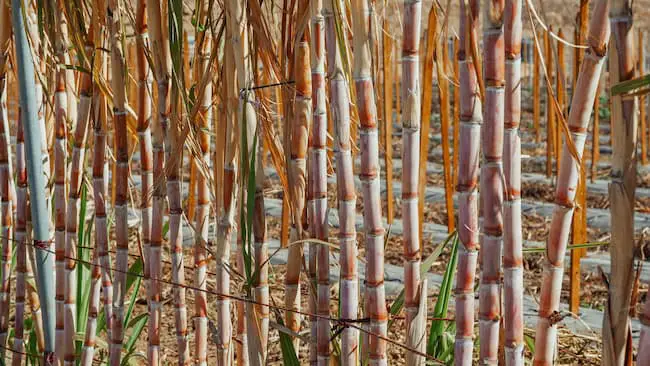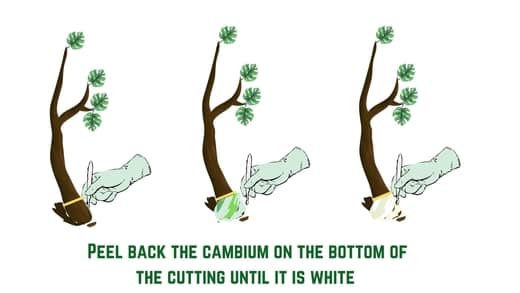This website is supported by its readers. If you click one of my links I may earn a commission. I am also a participant in the Amazon affiliates program and I will also earn a commission from qualified purchases.

With around 37 different species, it’s safe to say that sugar cane is easily one of the most important plants grown worldwide. Sugar and other sugar-derived products would not exist without this perennial grass species. With the move to homesteading gaining popularity, many people (myself included) want to grow our produce at home. Now, I’m asking how to grow sugar cane indoors.
To grow sugar cane indoors, take a four to six-inch cutting from a sugar cane stalk with at least one to two internodes. Place in a deep 12-inch pot and cover with potting soil. Move into a temperature-controlled room with plenty of light.
Now growing sugar cane indoors will be much more challenging than simply growing them outdoors in their native climates. So what sugar cane species grow best indoors? And what equipment will you need to grow your sugar cane indoors? Keep reading to find out more!
Just a quick heads up, over the past three years of running Plantpaladin, hundreds of people have asked for product recommendations. As such, You can find my favorite indoor bonsai tree here (link takes you to Bonsaiboy), my favorite outdoor bonsai tree (link takes you to Bonsaiboy), or have a look at all the products I recommend here.
Can you grow sugar cane indoors?
To understand this, I got in touch with my local botanical gardens, spoke to a few experts, and even got in touch with five plant paladin readers who grow their sugar cane to see if this was possible.
To summarize:
- Sugarcane can be grown in a pot indoors.
- To do so, you must mimic the environment Sugarcane grows naturally in, in an indoor environment.
- Sugarcane requires warm temperatures – typically between 65 to 90 degrees Fahrenheit ( 18 to 32 degrees Celsius.
- As such, if growing in a more moderate environment such as the UK or the pacific northwest as opposed to warmer conditions such as Florida, you will need to keep this plant indoors at a controlled temperature during the winter.
- As such, keeping this tree in a small greenhouse will give you the best chance of success in growing sugar cane indoors.
- Sugar cane also requires a lot of sunlight, typically between 6 to 8 hours of direct sunlight, so place it in a room full of windows during the summer and spring or ensure you invest in artificial grow lights to help grow the tree.
- Sugarcane also requires a long frost-free period to grow and thrive and a slightly lower temperature of around 53 degrees F ( 12 degrees c), which is used to ripen the sugar cane.
- On top of this, general regular care would be required ( like you would for any other plant)
- Ensure then that Sugarcane gets at least one to two inches of water per week, is regularly checked for tropical pests, and is kept in sandy, loamy soil that is repotted once every one to three years.
While sugar cane can then be grown indoors, it can be a lot more challenging.

Sugar cane quick facts ( table)
Sugar cane quick facts | Explained |
Sunlight requirements | Full sun - 6 to 8 hours per day. |
Watering | Water once to twice per week with a total of 1 to 2 inches. Aim to keep moist. |
Potting soil | A balanced loamy, sandy soil. Most peat or regular soils will work well. Avoid inorganic mixes. |
Temperature requirements | 65 to 90 degrees F. |
Fertilizer | Once per month with a high nitrogen and phosphorous fertilizer |
Time to grow | 9 to 24 months, depending on the climate. 12 months to harvest the cane. |
When to plant | Late summer |
height | 3 to 7 meters tall |
Fruit | None |
Pets | Sugarcane grubs, borers, aphids, mealybugs, spider mites, termites |
Growth rate | 12 to 24 inches per year |
How to grow sugar cane indoors? (step-by-step process)
So now we know that sugar cane can indeed be grown indoors; what exactly is the step-by-step process of growing your sugar cane indoors?
Gather your cuttings
The first thing you need to do is to take a cutting from your existing Sugarcane.
To do so, sterilize a saw, blade, or gardening shears.
You want to find a mature Sugarcane stalk from which you can cut.
So how much of the stalk will you need to cut?
Well, sugar canes have segments, most commonly referred to as nodes. For best results growing these indoors, you will want to take a cutting with at least one to two nodes.

Use your shears then and make a nice clean, even cutting that leaves you with a sugar cane stalk with one to two nodes.
Cuttings will typically be between six to twelve inches long for best results.
Gather your pot.
Once you have taken your cutting, the next step is to select the right pot.
For best results, you will want a pot that is deep enough so that the roots can spread out evenly and not get crushed, but a pot that is not so big that it will take up too much room in your indoor space.
I then recommended using something like a 10 to 12-inch pot. (You can find my recommendation here (link takes you to Amazon).

These pots will be deep enough to provide enough moisture, retention, and water flow in the spotting soil, but they will also mean that you won’t need to repot your sugar cane every few months.
If your cutting only has one node, you can get away with a smaller-sized pot.
Find your location.
So you are all set to plant your sugar cane indoors.
Before you do, however, I would figure out the location you will place your sugar cane indoors.
Most of you will be reading this post because you live in a climate too cool to grow these plants natively, so finding the perfect location will be critical.
Sugar cane will then require three main elements:
- A steady temperature year-round.
- Bright sunlight
- A steady water source.
Keeping these on a window sill might be possible in the first few months of growing your Sugarcane; however, these plants can grow tall, meaning it will only be a temporary solution.
For best results, keeping them inside a garage with a heater and artificial light or building a bespoke greenhouse space will be your best option if you want to grow these indoors.
Alternatively, if you have a conservatory or a living room with large windows, these too can make for fantastic options for growing your sugar cane indoors.
Just ensure that you maintain the temperature in these rooms during winter.
Treat your cutting to create new root growth.
This step is optional, but it’s what I undertook and worked well for my sugar cane.
I recommend this step if you live in cooler environments.
To do so, peel the bottom one to two centimeters on the cutting until the inner wood/sap is exposed.

Then use root hormone on the bottom one to two cm to help grow out new roots faster on the cutting.
You can then place them in a glass of water for a week with the rooting hormone while these new roots develop.
Once these new roots form, you can move on to the next step.
Fill your pot with soil.
Next, will your pot with soil until it is about ¾ full.
Now in terms of the spotting soil type, you want to go for a mix that provides ample aeration and moisture flows so that the roots do not become waterlogged or fungal infections develop but moist enough so that the soil is still damp.
Sandy, loamy soils then work best for your sugar cane.
You should keep a minimum soil depth of 45cm should be kept to help grow Sugarcane and aim to keep the soil’s PH level neutral between 6.5 to 7.5.
Avoid inorganic potting soils like those used in bonsai for Sugarcane, as their grit may prevent effective nutrient absorption.
Place your cutting
Next up, place your cutting in the potting soil.
To do so, use two fingers to create a small well that will be large enough for about 2 to 3 inches of the cutting to fit in.
This well will be deep enough to help keep the cutting upright.
Then, place the cutting with the roots ( or the bottom side of the cutting) in the well.
Top with the remainder of the potting soil until the lip of the pot has been covered.
You can then use a pencil or knitting needles to remove any clumps or air bubbles in the soil to ensure an even excellent distribution of soil.
Those of you using much larger cuttings might need extra help to ensure your Sugarcane stays upright.
If this is the case, use aluminum or copper wire tied to the drainage holes in the pot to help keep your sugar cane standing upright.
Move into a bright room.
Once potted, place your new sugar cane in the space we discussed earlier.
Try to give it an even distribution of sunlight and heat throughout the day.
If using artificial light or a heater, move your sugar cane around every few hours to ensure it is not burned or damaged.
Maintain good aftercare
Once your Sugarcane has been potted, you will need to maintain good aftercare over the next few months.
This included watering once to twice weekly to ensure the potting soil stays moist.
Ensuring yours provides ample sunlight.
Ensuring the temperature does not drop below 65F for too long and keep an eye out for pests and bugs that may want to attack and kill the sugar cane.
Conitue to grow for one to two years.
Should you grow sugar cane with seeds or with cuttings indoors?
You may be wondering why we decided to go down the cutting route instead of using seeds and planting them from scratch.
Well, Sugarcane grown indoors is already a difficult enough task – significantly, as most of us growing these indoors will be doing so away from the Sugarcane’s natural environment.
As such, it’s essential to use cuttings as this will speed up the process of growing our Sugarcane and leaves much less room for error.
Growing via seeds can still be undertaken. Just note that you will likely need a propagator and a bespoke greenhouse.
How often should you repot Sugarcane if grown indoors?
Repot sugar cane every two to three years if grown indoors. When you do repot, handle the plant gently and provide it with fresh, well-draining soil and adequate light and water.
Sugar cane, like most plants, needs to be repotted when it has outgrown its current pot, even if grown in indoor conditions.
The frequency of repotting will depend on the pot’s size, the plant’s growth rate, and the growing conditions.
Here are some general guidelines to follow when repotting indoor sugar cane:
- Observe the plant’s roots: Sugar cane plants have thick, fleshy roots that can quickly fill a small pot. If you see roots growing out of the drainage holes in the bottom of the pot, it’s time to repot the plant.
- Check the soil: Sugar cane plants like moist but well-draining soil. If the soil in the pot has become compacted or waterlogged, it’s time to repot the plant into fresh soil.
- Consider the size of the plant: Sugar cane plants can grow quite tall, so make sure to choose a big pot to accommodate the plant’s size. A good rule of thumb is to choose a pot that is at least twice the size of the current pot.
Can beginners grow sugar cane indoors?
So while sugar cane can be grown indoors in a pot – I can’t recommend it as something beginners should do.
The main reason is threefold:
- These plants are typically grown outside their climate if grown indoors.
- They will typically require large heat and sunlight requirements.
- They require more attention than other plants and trees.
As such, I recommend waiting until you have about two years of experience growing other plants before you decide to grow sugar cane indoors.
If you live in a warm hot climate and can grow Sugarcane natively outdoors, then this is something you can do as a beginner.
What materials do you need to grow sugar cane indoors?
So figuring out precisely what equipment you need when growing Sugarcane indoors can be a challenge.
As such, I’ve pulled together a list of materials you will need to grow sugar cane indoors:
Sugar cane plant.
You can purchase a mature sugar cane plant or start with a cutting (as outlined in this post) from a mature plant.
Pot
Choose a pot that is large enough to accommodate the size of the sugar cane plant and has suitable drainage holes.
Soil
Fill the pot with a well-draining soil mixture that is specifically designed for tropical plants.
I avoid using inorganic soil mixes commonly used for bonsai.
Water
Sugar cane plants prefer consistently moist soil, so be sure to have a source of clean water available.
I’d also aim to use rainwater or filtered water as opposed to tap or bottled water for the best results where possible.
Fertilizer
Use a balanced, water-soluble fertilizer every two to four weeks during the growing season to promote healthy growth.
Light
Sugar cane plants prefer bright, direct light. Place the plant near a sunny window or under grow lights if natural light is limited.
My recommendation for grow lights would be the Growingtop which you can grab here. (link takes you to Amazon)

Alternatively, feel free to read more information on my post here.
Humidity
Sugar cane plants prefer high humidity, so consider using a humidifier or placing a tray of water near the plant to increase the moisture in the air.
My recommendation for an air humidifier would be the Bluestone humidifier which you can grab on Amazon here.

Pruning shears
You may need to occasionally prune the sugar cane plant to control its size and shape.
Optional items include a humidity meter and a tray to catch water and prevent it from damaging surfaces.
With these materials, you can start growing your indoor sugar cane plant. Just be sure to provide consistent care and attention to keep the plant healthy and thriving.
Can you produce sugar from sugar cane grown indoors?
While it is possible to grow sugar cane indoors, producing sugar from a small indoor sugar cane plant is not practical or efficient. Sugar cane is a large, fast-growing tropical plant that requires significant cultivating space and resources.
Producing sugar from sugar cane involves a complex process of harvesting, cutting, pressing, and boiling the cane to extract the juice, which is then boiled and processed further to produce sugar. This process typically requires large-scale machinery and facilities, and performing it with a small indoor sugar cane plant is not feasible.
If you want to grow sugar cane as a hobby or for its ornamental value, it can make a great indoor plant. But there are better choices for producing sugar for practical purposes.
What species of sugar cane grows best indoors?
If you want to grow sugar cane as an indoor plant, Saccharum edule, also known as “dwarf sugar cane,” may be a good choice. This species is smaller and more compact than traditional sugar cane, making it a better fit for indoor cultivation.
Dwarf sugar cane can reach up to 4-5 feet in height, and it has a similar appearance to traditional sugar cane, with long, narrow green leaves and sturdy stalks.
This means it won’t take up too much room if grown indoors.
That said, you will still need to take your time to prune and cut this tree regularly to avoid any excess growth indoors.
There are several sugar cane species, but the most commonly cultivated species for sugar production is Saccharum officinarum. This species is not well-suited for indoor growth, as it requires a warm tropical climate and a lot of space to thrive.
Benefits of growing sugar cane indoors?
So while growing sugar cane indoors might not be super easy, what are some of the significant benefits if you decide to grow this plant indoors:
Ornamental value
Sugar cane is attractive, with tall stalks and long, narrow green leaves. Growing sugar cane indoors can add a tropical touch to your home and a great addition to any indoor garden.
Clean air
Like many other plants, sugar cane can help purify the air by removing harmful pollutants and producing oxygen. This can help improve air quality and contribute to a healthier indoor environment.
Humidity
Sugar cane prefers high humidity, and growing it indoors can help increase the moisture in the air. This can be especially beneficial in dry climates or during winter when indoor air can become dry and uncomfortable.
Educational
Growing sugar cane indoors can be a great educational experience for children or anyone interested in learning about tropical plants and the process of sugar production.
Overall, growing sugar cane indoors can bring a touch of the tropics to your home, improve air quality, and provide a low-maintenance, attractive indoor plant.
What are the drawbacks of growing sugar cane indoors?
Now like every plant, sugar cane also has several disadvantages if you decide to grow this plant indoors.
Heating costs
Most of you will be growing this tree in climates outside what is typical for sugar cane.
This means you will likely need to invest in grow lights, humidifiers, and heaters to maintain the perfect climate for your sugar cane.
As such, you can expect that to add a few dollars to your energy bills every month.
Size
Sugar cane grows relatively fast, at around 12 to 24 inches per year during the growing season.
As such, if kept unchecked, these tres can hit 4 to 5 meters in height.
This is typically taller than most ceilings in most houses.
As such, you must stay on top and regularly prune this tree to have a well-grown tree.
It will not produce sugar
As mentioned earlier on, sugar cane plants, if grown indoors, will not be able to produce sugar.
This is because heavy machinery is often needed to extract sugar directly from the tree and is something that only some of us can do from the comfort of our homes.
Light requirements.
Sugar cane prefers bright, direct light; without adequate light, it may become leggy and unattractive. If you don’t have access to a bright, sunny window, you may need to use grow lights to provide enough light for the plant to thrive.
How big can sugar cane grow indoors?
Most sugar cane grown indoors will reach between four and six feet in height (121 to 182cm). However, sugar cane grown indoors will still grow at a fast rate of 12 to 24 inches per year, so it will need to be pruned to ensure they do not overburden your indoor space.
The size of sugar cane plants grown indoors will depend on several factors, including the sugar cane species, the container size, and the amount of light and space the plant receives.
Dwarf sugar cane (Saccharum edule) is better suited for indoor cultivation than other sugar cane species and can reach up to 4-5 feet tall. However, this height can be controlled by regular pruning and limiting the container size.
Traditional sugar cane (Saccharum officinarum), typically grown for sugar production, can reach up to 20-30 feet in height in its natural habitat. However, indoor-grown sugar cane will be smaller in size and depend on the indoor space’s height and the container’s size.
It’s important to remember that indoor-grown sugar cane plants will produce different yields than outdoor plants, and the indoor space will limit their size.
Sunlight requirements for growing sugar cane indoors?
Sugar cane plants grown indoors require between 6 to 8 hours of direct sunlight year-round. If limited to sunlight, consider using a grow light to ensure your tree gets enough sunlight to remain healthy.
Water requirements for growing sugar cane indoors?
Water your indoor sugar cane with rain or filtered water two to three times per week. Aim to ensure the soil remains moist to avoid drought in the plant. Do not overwater, which can cause root rot.
What is the best temperature to grow sugar cane indoors?
The best temperature to grow sugar cane indoors is 65 to 90 degrees F or 18 to 32 degrees Celsus. This temperature will best mimic the climate in which these plants are grown naturally. Avoid temperature dropping below this for prolonged periods, as this will kill your tree.
Does sugar cane grow better indoors or outdoors?
While it is possible to grow sugar cane indoors, it is typically better suited for outdoor cultivation, with access to bright, direct sunlight and a warm, humid environment.
Outdoor-grown sugar cane can grow much more prominent and produce more sugar than indoor-grown plants.
Outdoor-grown sugar cane can also benefit from the natural conditions of its native habitat, including ample rainfall and warm temperatures, which are essential for optimal growth and sugar production.
Indoor-grown sugar cane can still be attractive and low-maintenance, but indoor conditions will limit its growth and sugar production. Indoor-grown sugar cane plants will be smaller and yield different from outdoor-grown plants.
Overall, while it is possible to grow sugar cane indoors, it is typically better suited for outdoor cultivation, with access to the warm, sunny conditions it needs to thrive and produce sugar.
What pests attack sugar cane indoors?
Growing sugar cane indoors can expose the plant to various pests, including.
- Spider mites: These tiny pests feed on the sap of sugar cane leaves, causing yellow spots and a spider-web-like appearance on the foliage.
- Mealybugs: Mealybugs are tiny, soft-bodied pests that feed on the plant’s sap and can cause wilting, yellowing leaves, and stunted growth.
- Scale insects: Scale insects feed on the sugar cane sap and can cause yellowing, stunted growth, and a sticky residue on the leaves.
- Aphids: Small insects feed on the plant’s sap and can cause yellowing, wilting, and stunted growth.
- Whiteflies: Whiteflies are tiny flying insects that feed on sugar cane sap and can cause yellowing, wilting, and stunted growth.
To prevent pest infestations, practicing good hygiene and sanitation in your indoor garden and keeping a close eye on your sugar cane plants for any signs of pest damage is essential.
If you notice a pest infestation, it’s essential to address it promptly to prevent the problem from spreading and causing more severe damage to your plants.
There are a variety of chemical and non-chemical methods that can be used to control pests on indoor-grown sugar cane. Still, it’s essential to choose the right solution based on the severity of the infestation and the size and age of your plants.
How long does sugar cane live indoors?
Most sugar cane trees grown indoors will live for 5 to 7 years if perfect conditions are met. In the wild, sugar cane trees will live much longer, with most outdoor natively grown sugar cane trees living for 20+ years.
However, the cane from sugar cane trees will typically ripen between 9 and 24 months.
Nine months will be reserved for sugar cane grown natively, whereas 24 months typically occur for sugar cane grown in cooler climates.
Survey results on if you can grow sugar cane indoors.
Finally, I wanted to ask a few plant paladin leaders who have grown sugar cane trees about their thoughts on whether you can grow a sugar cane plant indoors.
To summarize:

My top picks for the gear you will need!
So like I mentioned earlier, over the past three years of running PlantPaladin, hundreds of people have asked me for my recommendations on the best bonsai gear on the market.
Having spent thousands of dollars on bonsai items these past few years and tested at least 100 bonsai-specific products, I’ve listed my favorite products below – All of which I highly recommend and think you can get great value.
They can purchase directly by clicking the link to take them to Amazon.
Bonsai Tool Set: One of the significant challenges I’ve had is finding a toolset that was not only durable but didn’t break the bank. SOLIGT has recently developed a fantastic bonsai tool set that covers all the tools you need to trim, prune, and repot your trees. – You can grab it here.
Complete Bonsai Set: Many of you will want to grow your bonsai trees entirely from scratch, but finding the varicose seeds, pots, and other items in one place can be challenging. Leaves and Sole then have created a complete bonsai set that I’ve personally used that ticks all the boxes. You can grab it here.
Bonsai wire: The number of times I’ve run out of wire for my bonsai or purchased cheap bonsai wire that doesn’t do the job is embarrassing for me to admit. After a lot of trial and error, I found that using Hotop’s aluminum bonsai wire is one of the best options on the market. This can easily be used for both indoor and outdoor bonsai. You can grab it here.
This post was written by Fehed Nicass, who has been passionate about bonsai and gardening for over three years.



